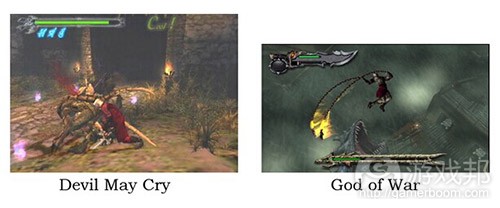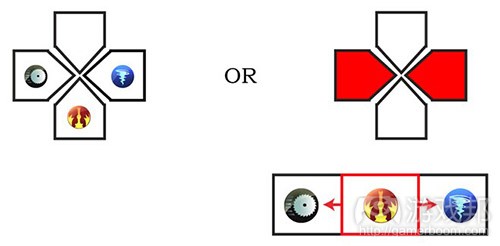分享独立动作游戏设计的一些经验
作者:Mike Shafer
你想成为一名游戏设计师?现在,由于许多独立项目的存在,许多人开始实现成为游戏设计师的梦想。我最初是以程序员身份接触电子游戏,但我的最新项目《Bain’s Redemption》却都是我一人分担多个角色完成的,其中就包括游戏设计。游戏设计有许多不同的方法。有些人会制作没人会去看的设计文档,其他人则会在实践中进行摸索。本文总结的是对我们来说可行与不可行的做法。
从《Bain’s Redemption》获得的经验
被动还是主动?
设计游戏有两种方法:被动或主动。顾名思义,就是我们要么边做边摸索,要么就事先制定好计划。事先做好计划有好处,至少可以避免美术人员捣鼓出一堆可能被弃用的东西。但与此同时,有时候你会放入一些你认为在纸面上可行,但执行到游戏中却并不管用的元素。从《Bain’s Redemption》的开发过程中我发现,你只能事先制定好计划。我们想创造一款像《Devil May Cry》或《战神》那样好玩的游戏,并尽自己最大的努力去维护它的可靠性。
我发现许多时候优秀设计与糟糕设计之间的区别就在于参数的执行。如果给予每个NPC 200的命值,大家就会抱怨游戏太困难了。给每个NPC 50的命值,那又太简单了。有些东西很难用数学来阐述,尤其是AI。它可以用概率来构造(多数AI有赖于概率),但对我来说这有点像是误称,因为概率并不存在构造这一说法。
我相信概率学者会有不同看法,但我们还是不要纠结于这一点了。例如,没有人会用你所知道的数学模型来规划游戏的AI,给特定的NPC规定它死亡或伤害玩家的机率。考虑以下图表的情况:
假设每个NPC,每秒都有从追踪玩家或者逃跑这两者间作出一个选择的机会。假设它们并不在乎自己的命值。即便这些假设都成立,我们也很难算出来自AI的dps(每秒伤害值)。鉴于这个情况,它们可能会在自己的命值或斗志很低的时候逃避,而你也只会让自己陷入一个噩梦般的数学计算中。最重要的是,不要忘了玩家是人类,此类计算必须服从于“终止问题”(即你无法知道玩家会如何玩游戏)。更常见的是,试试相关数值看看它们是否可行。
那么设计师该选择哪条路径呢?(被动还是主动?)我建议两者都有所取舍。如果你过于沉溺于被动路径,你可能就会抛弃你的美术人员/设计师/程序员所制作的重要资产。如果你过度偏向主动路径,你可能就会制作出一款各种元素配合并不妥当的游戏。
指示器
如果你想对任何游戏进行反向工程,最好先从UI开始。UI会告诉你关于游戏如何运行的大量信息。我们的游戏也不例外。观察我们游戏的UI,就可以看出很多东西来,一切事物的存在都是有原因的。
A是人物头像。它是许多游戏中的必要元素,但像《毁灭战士》巧妙地用头像来展示你的受伤状态更新一样,我们也用它来让玩家获知自己当前的心智状态(疯狂)。疯狂是我们游戏中的一个变量,当玩家使用愤怒(E)时就会将其计算在内。愤怒主要是在玩家受伤而非对他人造成伤害值时形成的。有些游戏有不同的战斗姿态,所以你可以自行决定是让玩家在造成伤害还是受伤时获得愤怒。B是当前特殊行动。控制器上的4个主按键不足以覆盖Bain的所有操作,所以我们决定将其中之一贡献给可用四个方向控制板进行转变的能力。这里的另一决策就是这四个方向是否分别属于一种操作,或者你可以通过左右/上下操作进行循环(见下图)。我们选择了后面一种设置。
C当然就是命值条。D则是冷却条。有些游戏会奖励你的行动,另一些游戏则会为你分配定额的行动。冷却条会分配定额行动,而愤怒条则会奖励你的行动。这两者如何避免冲突?冷却条会限制你能采取多少特殊行动而愤怒条则会增强你的行动(有时候包括一些使用冷却条的特殊行动)。《Devil May Cry》使用的是一种奖励操作的特殊行动条。换句话说,如果你什么都不做,你就无法执行特殊能力。在其他游戏中,你的操作次数就会有所限制。在《战神》中,你有一个可填充的魔法条,其作用类似于定额分配条,愤怒条也同样有限额。在《魔兽世界》中,盗贼使用限额行动的能量条,而战士则使用奖励行动的愤怒条。
平衡游戏
有一个玩法参数可能成为平衡良好的游戏与平衡糟糕的游戏之间的区别。玩家对此流行的口头禅就是“OP”。也就是这个行动过于强大了。因此,修改该行动时,就会产生一个所谓的“Nerfed”这种“过犹不及”的修改效应。每款游戏都有这种情况。这并不能照片于游戏的数学模型表达方式,而要归因于游戏设计不断试错的本性。当我看到某个行动过于强大时,我就会想修复它,但有时候它实在是过于失衡了,导致其参数需要翻倍或者减半,而其他时候它又只需要一些微妙的调整。判断你的游戏究竟需要大改还是微调,这本身就是一门艺术。
这正是优秀与糟糕设计师的区别所在。优秀设计师会持续调整玩法参数,直到感觉正确为止,而糟糕设计师只会调整一两次,并假设已经完工了。我注意到《Bain’s Redemption》中的疯狂就是OP。疯狂有0到1的数值,0就是理智的,而1就是疯狂的。当Bain发疯的时候,玩家就会失去对他的控制,必须摆摇杆重获控制权。我注意到在遭遇战之间这种疯狂会极大衰退。所以我调整了衰退率。该对象并不是用来显示疯狂机制,而是惩罚玩家过度使用愤怒值。换句话说,我们并不想每隔30秒就发疯一次只是为了看看它究竟是否存在。我们的这个机制有一个生态位,所有机制都需要一个生态位。Bain这一角色是矛盾的,所以愤怒与疯狂存在冲突也就不奇怪了。这正是设计的核心所在,它更像是一门艺术而非科学。记住,功能永远大于形式。
总结
我从《Bain’s Redemption》这款动作游戏的设计过程中获得许多经验。有些事情你就是得亲自尝试一下,看看它们究竟能否兼容。再多的计划也不能保证优秀的设计。平台游戏的设计文档可能会说玩家的跳跃将达到10英尺,但如果设计师设计的是一个极为自然的环境,某个悬崖的高度比另一个悬崖高了10英尺以上,你就得做出一些调整了。人类并非机器,我们的预测能力很有限。为何导演在拍摄电影时除了主要摄像器材外还要使用初级录像设备呢?因为导演无法预测电影成型的模样,只能通过这些设备先看看大致情况。任何优秀的动态系统都有一个类似的反馈循环,你可以将游戏想象成一个要求反馈的动态。简而言之,我并没有针对所有设计新人的万能建议。你只能自己去尝试并在这一过程中进行平衡。即使你完成了并且认为它很完美,也还是可能会在beta测试中发现一些需要修改的问题。所以要不断调整,调整再调整。当你完成的时候,还要再进行更多调整。
我们仍然可以从其他成功的游戏获得一些经验。我之前谈到了奖励行动和限制行动的能力指示器。你会发现许多成功动作游戏采用了这两者的不同特点。你使用哪一种则要取决于动作游戏的类型。最棒的设计师也同时是玩家。不妨停下来思考其中原因。这是由设计游戏的试错过程所决定的。设计师要花大量时间玩游戏。无论是查找漏洞还是测试参数,优秀设计师都是最了解自己游戏的人。试错并不是一个奢侈的做法,却是一个令游戏实现良好平衡的路径。(本文为游戏邦/gamerboom.com编译,拒绝任何不保留版权的转载,如需转载请联系:游戏邦)
Design of an Indie Action Game
By Mike Shafer
So you want to be a game designer? Now, more than ever, many people get to realize their dreams of becoming a game designer due to the number of Indie game projects available, catalyzed by the Internet. I started in video games as a programmer, but for my latest project, Bain’s Redemption, I had to wear many hats including game design. There are many different ways to design a game. Some make a design document that nobody reads (it’s happened to me) and others design as they go. This article describes what worked and what didn’t work for us.
What I Learned from Bain’s Redemption
Reactive or Proactive?
There are two ways to design a game: reactive or proactive. They are just as they sound, we either think it out as we go, or we plan ahead. It’s a good idea to plan ahead as you don’t want your artists to be working on something that might be tossed out. But at the same time, sometimes you put in elements that you think will work well together on paper, but once they are implemented in the game it just doesnt’ work. Learning from Bain’s Redemption, I realized you can only plan ahead so much. We wanted to create a game that was as fun as Devil May Cry or God of War, all the while doing our best to maintain its authenticity.
What I noticed is that a lot of times the difference between good design and bad design is the implementation of parameters. Give every NPC 200 health and everyone will complain that the game is too hard. Give every NPC 50 health and it will be too easy. Some things are hard to formulate mathematically, especially AI. It can be done with probability constructs, (most AI depends on probability), but to me that’s kind of a misnomer as probability lacks structure.
I’m sure probability scholars would beg to differ, but let’s just leave it at that. Nobody formulates the AI of their game with a mathematical model such that you know for example, that a particular NPC has a prescribed chance to die or chance to damage the player. Consider the figure below.
Let’s say each NPC, every second, once a second, has a chance of one in two (1:2) of either tracking the player or running away. Let’s assume they don’t care about their own health for a minute. Even with these assumptions, it is quite cumbersome to formulate what the rate of dps (damage per second) output would be from the AI. Add to this the fact that they would probably only cower when their health or morale is low and you got yourself a nightmare of a mathematical formulation. Lastly and probably most importantly, don’t forget that the player is a human and as such all formulation would be subject to the Halting Problem which basically means that you cannot know how the player will play the game. What is more common, is to try values out and see if they work.
So which route should the up and coming game designer choose? (Reactive or proactive)? I recommend a little bit of both. If you go too much into the reactive route, you may end up throwing away important assets that your artists/designers/programmers might make. If you go too much into the proactive route, you may make a game with elements that just don’t go well together.
Indicators, Indicators, Indicators…
If you ever want to reverse engineer the design of any game, the best place to start is the UI. The UI will tell you a whole lot about how the game works. Our game is no different. Observe the UI for our game. There is a lot going on, but everything has a purpose.
(A) is the portrait. It’s necessary in a lot of games, but just as Doom cleverly used the portrait to give a status update on your damage taken, we use this one to give the player an indication of his current mental state (insanity). Insanity is a variable in our game that counts up when the player uses rage (E). Rage is primarily built up by getting damaged and less so by doing damage. Some games have different combat stances that determine if rage (or its equivalent) is gained by doing damage or taking damage so this is a design decision you will have to make for your action game. (B) is the current special move. The four main buttons on the controller were not enough to cover all of Bain’s moves so we decided to devote one of them to an ability that can be changed with the four-directional pad. Another decision here is whether the four-directions are each a move, or you cycle through the moves with left/right or up/down (see diagram below). We chose the latter setup.
C) is of course the health bar. (D) is the cooldown bar. Some games reward you for action, while other games give you a quota for action. The cooldown bar gives you a quota for action while the rage bar rewards you for action. How do they not contradict? The cooldown bar limits how many special moves you can do while the rage bar enhances your moves (sometimes including special moves that use the cooldown bar). Devil May Cry went with a reward-for-action special move bar. In other words if you don’t do anything, you cannot perform special abilities. In other games, you are given a quota. In God of War, you are given a magic bar that fills up and as such acts as a quota (but is dependent on action still) as well as a rage bar that also acts as a quota. In World of Warcraft, rogues use an energy bar that is a quota for action while warriors use a rage bar that rewards you for action (while druids get both).
Balancing The Game
One gameplay parameter can be the difference between a well-balanced game and a poorly-balanced game. Gamers have a slang term for this: “OP.” That move is over-powered, they would say. Consequently, when that move is revised, there is an over-revised effect that happens that calls for another slang term: “Nerfed.” They nerfed that move, they would say. This happens in every game. It’s not due to the formulation of a mathematical model of the game, but due to the trial-and-error nature of game design. When I see a move is over-powered, I will try to fix it but sometimes it’s very off-balanced and its parameters need to be doubled or halved, other times it needs a subtle fix. Which one you will need for your game (big fix, or subtle fix) is an art form in itself.
This is what separates good designers from bad designers. Good designers will keep tuning gameplay parameters until it feels right, while bad designers might tune it once or twice and assume they are done. I noticed in Bain’s Redemption that insanity was OP. Insanity went from a value of 0 to 1, with 0 being sane and 1 being insane. When Bain goes insane, the player loses control of him and the player must wiggle the joystick to regain control. I noticed that between encounters the insanity would not decay sufficiently. So I adjusted the decay rate. Now consider that the object here is not to show off the insanity mechanic, but to penalize a player for over-using rage. In other words, we don’t want insanity to kick in every 30 seconds just to see that it exists. Rather, we have a niche for this mechanic as all mechanics need a niche. Bain as a character is conflicted, so it makes sense that rage conflicts with insanity. This is what design is like. It’s more of an art than a science I would say. Remember, form follows function.
Conclusion
I have learned a lot from Bain’s Redemption, in the context of design of an action game. Specifically, some things you just have to work out and see if they work well together. No amount of planning can guarantee good design. The design doc for a platformer might say the player’s jump will reach 10 feet, but if the designers design a heavily organic environment and a cliff ends up being more than 10 feet away from another cliff, you will have to make adjustments. Humans are not machines and we can only predict so much. Why do directors have rudimentary recording equipment (in addition to the main recording equipment) when they film a movie? It’s because the director cannot predict if the movie will look and play good without it actually being done (even with storyboarding the scene before hand!) Any good dynamical system has a feedback loop and as such, you can think of games as a dynamical system that requires feedback to be designed well. So in short, I don’t have a magic bullet piece of advice for anyone getting into design. You will have to try it and balance it as you go. And even when you’re done and you think it’s perfect, beta testing will bite you and tell you that something needs to be revised. So keep tuning and tuning and tuning. And when you are done, tune some more.
Still there are lessons to be learned from other games that have seen success. I talked about ability indicators that reward you for action and others that give you a quota for action. You will notice that the most popular action games incorporate different flavors of these two. Which you use will depend on the type of action game. The best designers are also gamers. Ever stopped and thought about why this is so? It is due to the trial-and-error process of designing games. Designers will spend a lot of time playing their game. Whether it’s looking for bugs or testing parameters, good designers will know the most about their game. There is nothing extravagant about trial-and-error, but it is the path to a well-balanced game.(source:gamedev)
上一篇:关于游戏分析当前所存在的问题
下一篇:公司该如何保持员工的活力与积极性










































 闽公网安备35020302001549号
闽公网安备35020302001549号